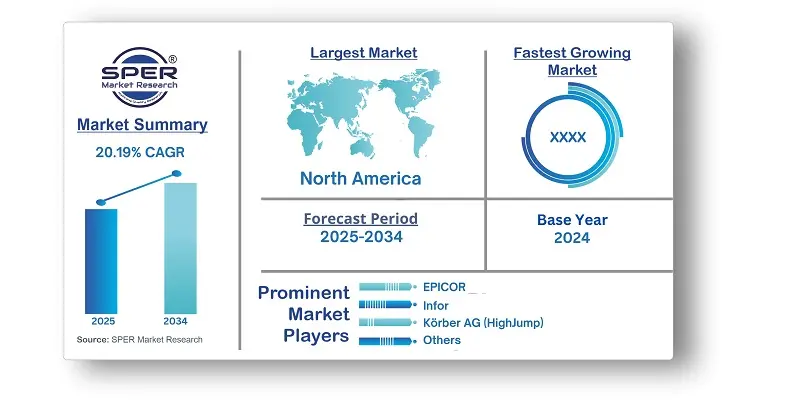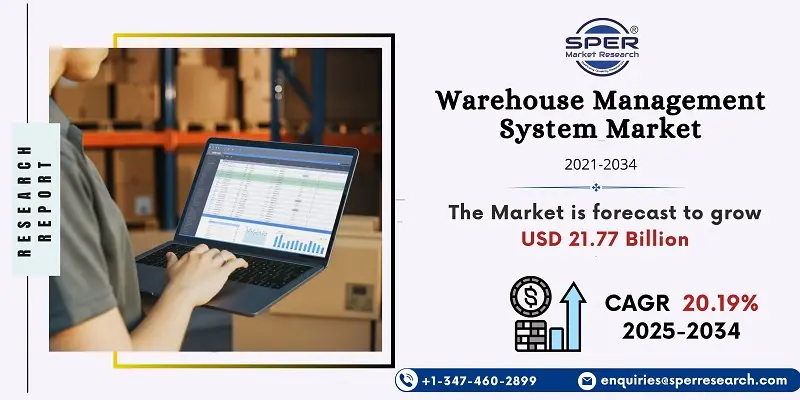Global Warehouse Management System Market Introduction and Overview
According to SPER Market Research, the Global Warehouse Management System Market is estimated to reach USD 21.77 billion by 2034 with a CAGR of 20.19%.
The report includes an in-depth analysis of the Global Warehouse Management System Market, including market size and trends, Interface mix, Applications, and supplier analysis. The market for warehouse management systems was valued at USD XX billion in 2024 and is expected to grow at a compound annual growth rate (CAGR) of XX% between 2025 and 2030. Globally expanding economies have driven a number of industries, including manufacturing, healthcare, and retail, to attain extremely efficient operations in order to boost production and satisfy customer demand. Logistics firms are constantly working to overcome obstacles brought on by shifting product marketplaces and delivery timetables in an effort to meet the increasing demands. The growing popularity of online shopping has raised the need for warehousing. Customers have turned to online shopping as a result of the pandemic's installation of lockdowns, social isolation, and other safety measures.
By Component Insights
The WMS market, the services segment held the predominant revenue share. This section encompasses consulting, system integration, operational, and maintenance services. Warehouse management services can also be offered by external vendors, contracted through WMS providers. Small and midsized businesses (SMEs) around the world are increasingly using WMS software, which is largely responsible for the growth.
By Deployment Insights
The cloud segment, holding the largest revenue share, is forecasted to expand at the quickest pace. Cloud-based technology has completely changed how companies operate. When implemented in the cloud, WMS significantly boosts warehouse efficiency while lowering upfront expenses for businesses. Nonetheless, with the advent of WMS, on-premise installations have gained popularity. It is characterized by large servers and expensive maintenance, which eventually raises the company's expenses.
By Function Insights
It is anticipated that the analytics and optimization segment will increase at the quickest rate. However, throughout the same time period, the systems integration and maintenance section are probably going to contribute the most money. One of the most important components of the warehouse management optimization package that automates the paper-based picking process is order picking functionality.
By Application Insights
The sector predicted to experience the most rapid expansion is transportation and logistics. E-commerce portals' expanding popularity and consumers' rising levels of disposable income, particularly in developing countries like China and India, are to blame for the surge. WMS is rapidly embraced by logistics and supply chain companies to improve their processes and increase warehouse productivity and efficiency. At first, manufacturing companies integrated their WMS with ERP systems.
By Regional Insights
The WMS market was primarily led by Europe, followed by Asia Pacific and North America. Key factors fuelling the expansion of the WMS market in Europe include advancements in warehouse management systems and an increasing recognition of cloud-based warehouse management systems. The Warehouse Management System (WMS) market in North America is growing due to several reasons, such as the presence of large networks of third-party logistics (3PL) providers and major corporations with global reach distribution and warehousing activities, and the ongoing expansion of the e-commerce sector.
Market Competitive Landscape
The participants in the market are focusing on various strategies to grow their market share. To become the leading warehouse management system company, they are announcing collaborations, mergers, acquisitions, and other contractual agreements. Some of the prominent players in Global Warehouse Management System Market are EPICOR, Infor, Körber AG (HighJump), Made4net, Manhattan Associates, Oracle, PSI Logistics, Reply, SAP, Softeon.
Recent Developments:
In October 2022, to launch Qualtrics XM for suppliers, SAP partnered with Qualtrics, a cloud-based software platform provider that specializes in experience management. This solution was created to help businesses improve their supply chain operations, secure essential supplies, save costs, manage risks, and increase overall business agility. It also empowers enterprises to pinpoint areas where the source-to-pay process needs to be improved.
In March 2022, Snowflake, a cloud-oriented data warehousing service that offers a completely managed, scalable, and flexible data platform, revealed its partnership with Blue Yonder Group, Inc. The collaboration brought together the scalable and secure data platform of Snowflake with the experience of Blue Yonder Group, Inc. Through technology integration, the companies sought to give enterprises real-time access to supply chain data so they could make better decisions, streamline processes, and increase productivity.
Scope of the report:
| Report Metric | Details |
| Market size available for years | 2021-2034 |
| Base year considered | 2024 |
| Forecast period | 2025-2034 |
| Segments covered | By Component, By Deployment, By Function, By
Application |
| Regions covered | North America, Latin
America, Asia-Pacific, Europe, and Middle East & Africa |
| Companies Covered | EPICOR, Infor, Körber AG
(HighJump), Made4net, Manhattan Associates, Oracle, PSI Logistics, Reply, SAP, Softeon. |
Key Topics Covered in the Report
- Global Warehouse Management System Market Size (FY’2021-FY’2034)
- Overview of Global Warehouse Management System Market
- Segmentation of Global Warehouse Management System Market by Component (Software, Services)
- Segmentation of Global Warehouse Management System Market by Deployment (On-premise, Cloud)
- Segmentation of Global Warehouse Management System Market by Function (Labor Management System, Analytics & Optimization, Billing & Yard Management, Systems Integration & Maintenance, Consulting Services)
- Segmentation of Global Warehouse Management System Market by Application (Transportation & Logistics, Retail, Healthcare, Manufacturing, Food & Beverage, Others)
- Statistical Snap of Global Warehouse Management System Market
- Expansion Analysis of Global Warehouse Management System Market
- Problems and Obstacles in Global Warehouse Management System Market
- Competitive Landscape in the Global Warehouse Management System Market
- Details on Current Investment in Global Warehouse Management System Market
- Competitive Analysis of Global Warehouse Management System Market
- Prominent Players in the Global Warehouse Management System Market
- SWOT Analysis of Global Warehouse Management System Market
- Global Warehouse Management System is Market Future Outlook and Projections (FY’2021-FY’2034)
- Recommendations from Analyst
1. Introduction
1.1. Scope of the report
1.2. Market segment analysis
2. Research Methodology
2.1. Research data source
2.1.1. Secondary Data
2.1.2. Primary Data
2.1.3. SPER’s internal database
2.1.4. Premium insight from KOL’s
2.2. Market size estimation
2.2.1. Top-down and Bottom-up approach
2.3. Data triangulation
3. Executive Summary
4. Market Dynamics
4.1. Driver, Restraint, Opportunity and Challenges analysis
4.1.1. Drivers
4.1.2. Restraints
4.1.3. Opportunities
4.1.4. Challenges
5. Market variable and outlook
5.1. SWOT Analysis
5.1.1. Strengths
5.1.2. Weaknesses
5.1.3. Opportunities
5.1.4. Threats
5.2. PESTEL Analysis
5.2.1. Political Landscape
5.2.2. Economic Landscape
5.2.3. Social Landscape
5.2.4. Technological Landscape
5.2.5. Environmental Landscape
5.2.6. Legal Landscape
5.3. PORTER’s Five Forces
5.3.1. Bargaining power of suppliers
5.3.2. Bargaining power of buyers
5.3.3. Threat of Substitute
5.3.4. Threat of new entrant
5.3.5. Competitive rivalry
5.4. Heat Map Analysis
6. Competitive Landscape
6.1. Global Warehouse Management System Market Manufacturing Base Distribution, Sales Area, Interface Type
6.2. Mergers & Acquisitions, Partnerships, Interface Launch, and Collaboration in Global Warehouse Management System Market
7. Global Warehouse Management System Market, By Component 2021-2034 (USD Million)
7.1. Software
7.2. Services
8. Global Warehouse Management System Market, By Deployment 2021-2034 (USD Million)
8.1. On-premise
8.2. Cloud
9. Global Warehouse Management System Market, By Function 2021-2034 (USD Million)
9.1. Labor Management System
9.2. Analytics & Optimization
9.3. Billing & Yard Management
9.4. Systems Integration & Maintenance
9.5. Consulting Services
10. Global Warehouse Management System Market, By Application 2021-2034 (USD Million)
10.1. Transportation & Logistics
10.2. Retail
10.3. Healthcare
10.4. Manufacturing
10.5. Food & Beverage
10.6. Others
11. Global Warehouse Management System Market, 2021-2034 (USD Million)
11.1. Global Warehouse Management System Market Size and Market Share
12. Global Warehouse Management System Market, By Region, 2021-2034 (USD Million)
12.1. Asia-Pacific
12.1.1. Australia
12.1.2. China
12.1.3. India
12.1.4. Japan
12.1.5. South Korea
12.1.6. Rest of Asia-Pacific
12.2. Europe
12.2.1. France
12.2.2. Germany
12.2.3. Italy
12.2.4. Spain
12.2.5. United Kingdom
12.2.6. Rest of Europe
12.3. Middle East and Africa
12.3.1. Kingdom of Saudi Arabia
12.3.2. United Arab Emirates
12.3.3. Qatar
12.3.4. South Africa
12.3.5. Egypt
12.3.6. Morocco
12.3.7. Nigeria
12.3.8. Rest of Middle-East and Africa
12.4. North America
12.4.1. Canada
12.4.2. Mexico
12.4.3. United States
12.5. Latin America
12.5.1. Argentina
12.5.2. Brazil
12.5.3. Rest of Latin America
13. Company Profile
13.1. EPICOR
13.1.1. Company details
13.1.2. Financial outlook
13.1.3. Interface summary
13.1.4. Recent developments
13.2. Infor
13.2.1. Company details
13.2.2. Financial outlook
13.2.3. Interface summary
13.2.4. Recent developments
13.3. Körber AG (HighJump)
13.3.1. Company details
13.3.2. Financial outlook
13.3.3. Interface summary
13.3.4. Recent developments
13.4. Made4net
13.4.1. Company details
13.4.2. Financial outlook
13.4.3. Interface summary
13.4.4. Recent developments
13.5. Manhattan Associates
13.5.1. Company details
13.5.2. Financial outlook
13.5.3. Interface summary
13.5.4. Recent developments
13.6. Oracle
13.6.1. Company details
13.6.2. Financial outlook
13.6.3. Interface summary
13.6.4. Recent developments
13.7. PSI Logistics
13.7.1. Company details
13.7.2. Financial outlook
13.7.3. Interface summary
13.7.4. Recent developments
13.8. Reply
13.8.1. Company details
13.8.2. Financial outlook
13.8.3. Interface summary
13.8.4. Recent developments
13.9. SAP
13.9.1. Company details
13.9.2. Financial outlook
13.9.3. Interface summary
13.9.4. Recent developments
13.10. Softeon
13.10.1. Company details
13.10.2. Financial outlook
13.10.3. Interface summary
13.10.4. Recent developments
13.11. Others
14. Conclusion
15. List of Abbreviations
16. Reference Links


































